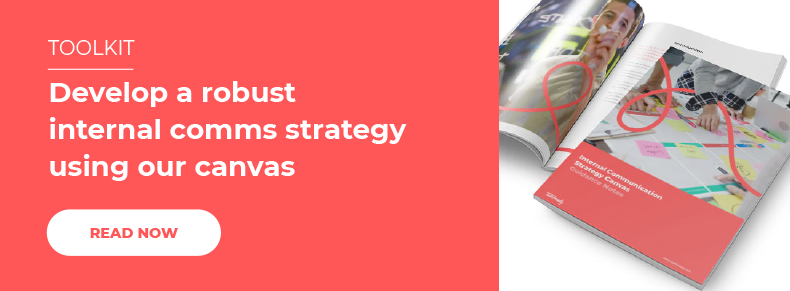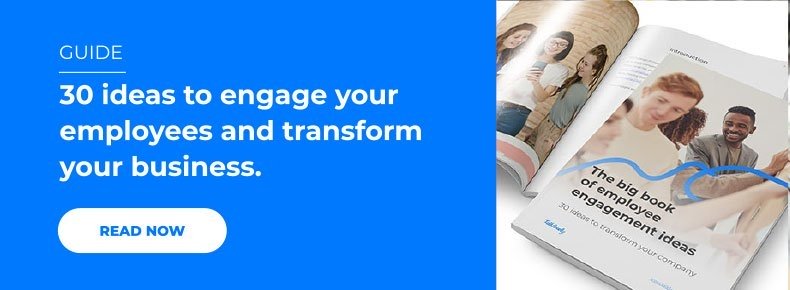Failing to plan is planning to fail. Preparation is the key to success, and this applies to internal communications just as much as any other aspect of your business. It has become increasingly clear that effective communication is an essential element of any organisation. An effective internal communication plan is a critical aspect of your daily operations.
Most organisations have carefully constructed procedures for communicating with clients, stakeholders and new hires. When you apply the same level of care to your employee communication plan, you will see a definite uplift in engagement.
All too many organisations have taken a set-it-and-forget-it approach to their internal communications plans. However, times have changed, and that tactic just won’t wash anymore. With the switch to hybrid working patterns, the need for effective communication in the workplace and beyond has become critical. It has become increasingly clear that when you shift your focus back to connecting meaningfully with your employees, the benefits to your business are manifold.
In this blog, we look at why it is so important to concentrate on internal communication planning. We drill down into how to construct a highly effective internal communication strategy that will deliver definite results in today’s business climate; the five key questions you need to ask and the five critical mistakes to avoid. We also put you on the right track with our ready-to-go strategy canvas template.
Why you need an internal communication plan for 2024
What is an internal communication plan, and why is it so important in the current situation? A successful plan will clearly define your business goals in communicating with employees and sets out the activities required to achieve these goals. In essence, it’s the blueprint steering you towards internal communications success.
The benefits of good internal communication are many and varied. When a strong employee engagement communication plan is in place, it guarantees staff loyalty, motivation and productivity.
Your updated employee communication plan will need to address the worldwide switch to hybrid working. According to research by the Harvard Business Review, employees are seeking out communication more than ever. By ensuring that even the hard-to-reach employees are connected, you’ll be back in control of your internal communication process.
In contrast, poor internal communication can have an extremely negative effect on your business. It can lead to lowered morale, confusion and reduced productivity and profits. Ultimately, it can seriously harm your bottom line. A Towers Watson study revealed that companies that communicate ineffectively are 50% more likely to report below-average turnover.
Five Do’s: The questions you need to ask
When you are focusing on how to improve internal communication, creating a detailed internal communication strategy and action plan is the place to start. Before you begin, step back and ask yourself these five essential questions. The answers to these questions will lay the foundation of your plan and set you up for success.
Question #1: Why?
What is your overall business or project goal? Have you defined what value you are going to add?
To get the most out of your internal communication planning, you need to define your end goal. This will be different for every business. For some organisations, the focus will be on staff retention levels, while for others it will be about improving productivity. As a result of the pandemic, you may be tackling the thorny problem of communicating change, or connecting with remote workers. If so, your strategy will need to focus on this as a priority.
To define your core target, you may need to discuss different views with stakeholders until you agree on a common goal. This stage rarely takes place in isolation. Once you have strong, clear objectives, the rest of your plan will fall into place much more easily.
Do This:
Do focus on nailing down what you want to change as a result of your communication. Without a defined goal, there is no point in doing it.
Question #2: Who?
Who is this specific communication aimed at? What do you want people to do differently as a result?
Never forget to focus on who your communications are aimed at. How can you make it relevant to your target audience? Your staff already have a lot on their minds, from the details of the task they have in hand to worries about what the future has in store for their job, to personal matters and concerns. The role of internal communications is to cut through all this noise and get your message heard.
To get, and keep, your employee’s attention you will need to understand your audience and what information they will find interesting and important. It may be helpful to segment the audience into specific groups, for example:
- Age/stage: pensions communications will require a different approach for graduate trainees from those approaching retirement.
- Location/culture: employees in HQ are often easier to connect with than those working remotely.
- Teams/departments: the catering, accountants and customer service teams may all work in the same building but will have different concerns and priorities.
- Attitude/outlook: are they feeling well disposed towards the organisation or undervalued and demotivated?
Do This:
Incorporate a range of techniques into your plan to allow for individual differences. You can’t expect a single approach to work for every employee.
Question #3: What?
What are you asking people to engage with? And why should they care?
Start by putting aside the finer details and concentrating on the core idea you hope employees will understand and be inspired by. When you're putting together your internal communication plans, you need to be very clear about the main point.
You also need to factor in the “why should I care?” question. Staff will see everything you are saying through their own personal prism. For example:
- Will I still have a job at the end of this?
- Am I going to have to change the way I work?
- Is this yet another brilliant idea from HQ that ends up going nowhere?
Your employee communication plan will work best if you have already honed down some outcomes that will interest them. Consider drawing up some innovative internal communication ideas to get them fired up. Ideally, their job is going to become easier and more enjoyable. But on the other hand, it’s important to accept that some communications will have no silver lining. Do not expect to be able to put a positive spin on everything.
Do This:
Implement the Know-Feel-Do approach:
- KNOW: What your audience needs to know for them to agree with or understand the action/change.
- FEEL: What they need to feel or believe, to be ready to do it.
- DO: What you want them to do as a result of the communication.
Question #4: When?
Are other messages or events going to overshadow your timing? Are you maintaining a regular schedule of communications?
Timing is crucial. Make sure your timing does not conflict with big news events already in the corporate diary. Timing is also a critical factor when it comes to a sensitive announcement such as job losses. There is a fine line between announcing too early with incomplete information and leaving it too late until the rumour mill is in overdrive.
Another factor to consider is the pace of your internal communications. The internal communications best practice is to maintain a regular, scheduled and consistent pace of messaging. This is especially crucial for remote workers who don’t have the opportunity for regular, casual catchups with their managers and peers. When your communications become intermittent, engagement levels begin to suffer as employees feel forgotten and side-lined.
Do This:
Use a dedicated app to handle your scheduling. An internal communication app will give you the tools to schedule timely communications and deliver a steady stream of information to your employees.
Question #5: How?
Which channel will work best for the content and the audience you have in mind?
It’s important to bear in mind that how a message is transmitted is as important as the message itself. When you are building your internal communication strategy and action plan, the channel you choose will be a key factor.
When faced with a huge selection of internal communication channels, you need to consider which one will best engage your employees. Will they respond to a company-wide email, a social media blast, or perhaps a daily news feed? Your best option is always to provide a choice of channels to allow for a personalised experience and break down any possible barriers.
When it comes to selecting effective internal communication tools, remember you’re looking for a way to support that all-important two-way communication. Rather than simply delivering information, you need to allow an opportunity for your employees, both office-based and remote, to reply and respond.
Do This:
Allow the employee voice to be heard. Make sure you provide a two-way communication channel for maximum engagement.
Five Don’ts: The mistakes to avoid
So now you have the answers to those five vital questions, you’re ready to start building your internal communication plan. However, as you construct your strategy, here are five common internal communication mistakes you will need to avoid making.
Mistake #1: Guesswork
Don’t just assume your employee engagement communication plan is working. Monitor it carefully. All effective plans place a heavy focus on internal communications metrics.
Assess the priorities you identified by asking ‘Why?’ by carefully evaluating whether your internal communication plans are delivering.
Internal communications software makes life easy. Thanks to the built-in reporting, it will continually evaluate the success of your employee communications.
Mistake #2: Overload
People find it hard to absorb multiple or complex messages, so keep it simple. It is a sad truth that employees often have far less understanding than the management team realises. A recent IBM survey revealed that 44% of employees feel that managers don’t provide clear information about the company’s vision, and 72% don't have a full understanding of the company's strategy.
Make sure you use suitable language and appropriate channels for your messages. Always bear your audience in mind when constructing communications.
Mistake #3: Irregularity
One common error is to transmit all your messages in a big information blast and then put messaging on the back burner for a while. This stop-start approach will negatively affect your employees' engagement levels. A steady drip feed of news, reports, advice, and surveys will keep staff connected and motivated.
Regular messaging is made simple with an internal communications app. It allows you to pre-schedule news and updates, so you can get on with other business matters.
Mistake #4: Disconnect
Keep a finger on the pulse of your workforce. It’s easy for senior management to experience a disconnect from employees, which then results in a failure to communicate effectively. This is even more of a concern with a dispersed, hybrid workforce. Try to understand the daily reality of their jobs by connecting and listening to your employees.
Spend time talking and listening to employees to learn how your organisation works from their perspective.
Mistake #5: Priorities
Try to avoid the common ‘me, me, me’ pitfall. Obviously, you want your internal communications to be your employee’s top priority but this can’t always be the case. Remember to take into account their other projects and responsibilities as you construct your messages. Look for ways to cut through the noise and make yourself heard.
An internal communications app allows you to personalise your communications to suit your employee’s priorities and preferences.
Why you should use an internal communications canvas
It can be hard to know where to start when constructing your internal communications plan. That’s where a canvas can be a lifesaver. It will help you visualise your approach and gain an overview of your plans.
What is a canvas? It’s a diagram that gives a broad overview of your current business needs. It helps you to select and improve internal communication channels, identify risks and challenges, and highlight areas to target. With a canvas, you’ll ensure that you create a comprehensive plan that covers all bases. It will make sure you cover all aspects of the business, reach every employee, meet your objectives and measure the impact of your strategy.
Here at TalkFreely, we’ve drawn up a strategy canvas template to get started. It also includes a 20-page guide to help you define your internal communications planning. With a canvas in place, you’ll have a solid framework for shaping communication channels and defining goals for your strategy. Download your free guide here.
An example internal communication plan
So, what does the perfect employee communication plan look like? In truth, it will be different for every organisation, as your overriding aims and goals will be unique to your individual business. However, as a starting point, this example inspired by Fitzpatrick and Valskov is an example of best practice in action.

Your internal communication plan
We all have too many priorities bearing down on us at work. But one place we can’t cut corners is in the planning. Robust preparation is the key to success in most things, and this is all too true in internal communications. Having a strategic internal communications plan in place is a critical step to ensure your operations are organised, prioritised and operating at their optimum.
Ask the five key questions, avoid the five common mistakes and use a canvas to help you define your strategy. You’ll soon be well on your way to creating a successful internal communication plan for 2024.









.jpg)
.jpg)